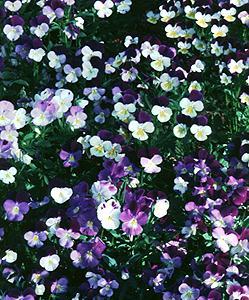March
2001
Did you know how many
species from genus Viola are familiar to us today?
Be they pansies, violets, or Johnny-jump-ups, members of the genus Viola have earned a place in our hearts as
well as in our gardens.
Where did violas come from? One theory
goes that Jupiter, the chief god in the ancient Roman pantheon, created the sweet flowers
as food for his mistress Io, whom he had disguised as a cow to protect her from the wrath
of his wife, Juno. More likely, the genus came not from the heavens but from Central
Europe and Asia, with several species originating in North America, as
well. Throughout history, this delightful family of herbs has brought smiles and the promise of relief from
complaints as diverse as depression, excessive thirst, and rheumatism.

Viola Cornuta "Cuty"
|
While hundreds of species make up the
genus Viola (a member of the family Violaceae), barely a handful are familiar to us
today. The common sweet violet (V. odorata), a woodland perennial, was favored by
the ancient Athenians as a cure for hangovers, employed as a sweetener by monks in the
Middle Ages, and until the First World War served as the main ingredient in England's
best-selling toilet water. Also fragrant, the perennial horned violet (V. cornuta),
a Swiss native, became a popular ground cover in England after its introduction there in
1776; the pale-blue, white, or mauve blossoms bear delicate spurs and -- under the right
conditions -- flourish from April until frost.
source:
http://homearts.com/cl/garden/03violf1.htm
|
